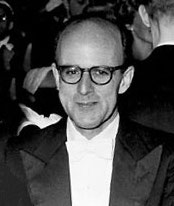Max Ferdinand Perutz
| Max Perutz | |
|---|---|

Perutz in 1962, age 52
|
|
| Born | Max Ferdinand Perutz 19 May 1914 Vienna, Austria-Hungary |
| Died | 6 February 2002 (aged 87) Cambridge, Cambridgeshire, England |
| Nationality | British |
| Fields | Molecular biology, Crystallography |
| Institutions | University of Cambridge, Laboratory of Molecular Biology |
| Alma mater |
University of Vienna Peterhouse, Cambridge |
| Doctoral advisor | J.D. Bernal |
| Doctoral students | Francis Crick; John Keith Moffat |
| Known for | Heme-containing proteins |
| Notable awards |
|
| Spouse | Gisela Clara Peiser (m. 1942; 2 children) |
Max Ferdinand Perutz OM CH CBE FRS (19 May 1914 – 6 February 2002) was an Austrian-born British molecular biologist, who shared the 1962 Nobel Prize for Chemistry with John Kendrew, for their studies of the structures of haemoglobin and myoglobin. He went on to win the Royal Medal of the Royal Society in 1971 and the Copley Medal in 1979. At Cambridge he founded and chaired (1962–79) The Medical Research Council Laboratory of Molecular Biology, fourteen of whose scientists have won Nobel Prizes. Perutz's contributions to molecular biology in Cambridge are documented in The History of the University of Cambridge: Volume 4 (1870 to 1990) published by the Cambridge University Press in 1992.
Perutz was born in Vienna, the son of Adele "Dely" (Goldschmidt) and Hugo Perutz, a textile manufacturer. His parents were Jewish by ancestry, but had baptised Perutz in the Catholic religion. Although Perutz rejected religion and was an atheist in his later years, he was against offending others for their religious beliefs.
His parents hoped that he would become a lawyer, but he became interested in chemistry while at school. Overcoming his parents' objections he enrolled as a chemistry undergraduate at the University of Vienna and completed his degree in 1936. Made aware by lecturer Fritz von Wessely of the advances being undertaken at the University of Cambridge into biochemistry by a team led by Gowland Hopkins, he asked Professor Marks who was soon to visit Cambridge to make inquiries to Hopkins about whether there would be a place for him. However Marks forgot. However he had visited J.D. Bernal, who was looking for a research student to assist him with studies into X-ray crystallography. Perutz was dismayed as he knew nothing about the subject. Marks countered by saying that he would soon learn. Bernal accepted him as a research student in his crystallography research group at the Cavendish Laboratory. His father had deposited £500 with his London agent to support him. He learnt quickly. Bernal encouraged him to use the X-ray diffraction method to study the structure of proteins. As protein crystals were difficult to obtain he used horse haemoglobin crystals, and began his doctoral thesis on its structure. Haemoglobin was a subject which was to occupy him for most of his professional career. He completed his Ph.D. under William Lawrence Bragg.
...
Wikipedia
